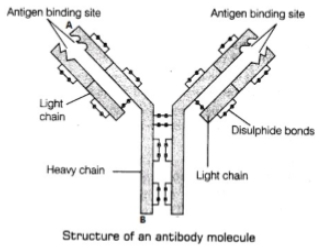In the given diagram, A and B represent respectively:

1. The N and the C terminus of the polypeptide
2. The C and the N terminus of the polypeptide
3. The constant and variable regions of the antibody molecule
4. The variable and constant regions of the antibody molecule

Consider the given stages in the life cycle of Plasmodium and choose the correctly matched pair :
1. A : Merozites infect human when mosquito bites
2. B : Parasite reproduced sexually in liver cells
3. C : Symptoms of malaria
4. D : Fertilization in hemocoel of the mosquito
Consider the following statements:
| I. | Plasmodium falciparum causes malignant tertian malaria |
| II. | Release of hemosiderin from burst RBCs is responsible for paroxysms of malarial attacks |
| III. | Sporozoites are the infectious forms of Plasmodium |
Which of the above statements are true?
1. I and II only
2. I and III only
3. II and III only
4. I, II, and III
Consider the following statements:
I. Morphine is clinically used as an analgesic and its receptors are located in CNS and GIT.
II. Cocaine and amphetamines are CNS stimulants and the later is used clinically to treat narcolepsy and morbid obesity.
III. Atropine is a parasympathomimetic drug used to dilate pupil and increase heart rate.
Which of the above statements are true?
1. I and II only
2. I and III only
3. II and III only
4. I, II and III
Consider the following statements:
I. Cancer is essentially a genetic disease caused by multiple mutational events.
II. Cancerous cells are rapidiy dividing cells that exhibit contact inhibition.
III. Metastasis is the most feared complication of any cancer
Which of the above statements are true?
1. I and II only
2. I and III only
3. II and III only
4. I, II and III
Consider the following statements:
I. HIV is a reterovirus.
II. It infects and destroys the CD4 T-ymphocytes
III. The newer antiretroviral drugs are a cure for HIV infection
Which of the above statements are true?
1. I and II only
2. I and III only
3. II and III only
4. I, II and III
Consider the following statements:
I. Innate immunity is non-specific type of defence, that is present at the time of birth.
II. Acquired immunity is pathogen specific and is characterized by memory
III. Memory-based acquired immunity developed in higher vertebrates based on ability to distinguish self from non-self
Which of the following statements are true?
1. I and II only
2. I and III only
3. II and III only
4. I, II and III
Match each disease with its correct type of vaccine.
|
Column I |
Column II |
|
A. Tuberculosis |
1. Harmless virus |
|
B. Whooping cough |
2. Inactivated toxin |
|
C. Diphtheria |
3. Killed bacteria |
|
D. Polio |
4. Harmless bacteria |
Codes:
|
|
A |
B |
C |
D |
|
(1) |
2 |
1 |
3 |
4 |
|
(2) |
3 |
2 |
4 |
1 |
|
(3) |
4 |
3 |
2 |
1 |
|
(4) |
1 |
2 |
4 |
3 |
Transplantation of tissues/organs fails often due to non-acceptance by the patient's body. Which type of immune-response is responsible for such rejections?
(1) Autoimmune response
(2) Cell-mediated immune response
(3) Hormonal immune response
(4) Physiological immune response
Which of the following sets of diseases is caused by bacteria?
(1) Cholera and tetanus
(2) Typhoid and smallpox
(3) Tetanus and mumps
(4) Herpes and influenza







